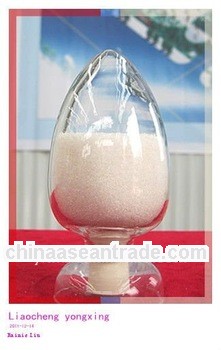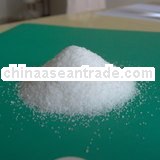Brand:aa
Product detail:
water treatment pam polyacrylamide
Parameters
| Main technical indicators name | anionic PAM | nonionic PAM | cationic PAM |
| Appeatance | white granule/powder | white granule/powder | white granule/powder |
| grain diameter(mm) | <2 | <2 | <2 |
| insoluble soild in water | ≤2 | ≤2 | ≤2 |
| molecular weight(milion) | 12-25 | 3-12 | 6-18 |
| degree of hydrolysis(%) | 10-35 | 5-15 | 20-60 |
| soild content(%) | ≥88 | ≥88 | ≥88 |
1.Quick Details
| Classification: Chemical Auxiliary Agent | CAS No.: 9003-05-8 | Other Names: APAM,NPAM,PHPA |
| MF: C8H803 | EINECS No.: 98-71-5 | Purity: 90% |
| Place of Origin: Shandong China (Mainland) | Type: flocculating agent | Usage: paper making, coal mining,textile. |
| Brand Name: ST-ARN | Model Number: ST-PAM119 | CAS: 9003-05-8 |
2.Usages:
Polyacrylamide can be used by selecting different molecular weights according to different purposes and user requirements on product performance.
1)Sludge Dewatering: As a flocculating agent, mainly used in industrial solid-liquid separation process, including settlement, to clarify,concentrate and sludge dewatering processes, applications for all the major sectors are: urban sewage treatment,paper,food processing, petrochemical, metallurgical, processing, dyeing and the sugar and all kinds of industrial wastewater treatment.
The product has special good effect to suspended matter in organic colloidal state and can accelerate dehydration and filtration of sludge rapidly. The relevant type can be chose based on the character of sludge, and the product will not stick to filter cloth during dehydration and will not loosen when filter pressing with a high efficiency.
2)Treatment of Sewage Water and Organic Waste Water:
the product shows electropositivity in acid or alkaline media, thereby the product is extremely effective for flocculation, sedimentation and disambiguition of sewage water whose suspended particulates are provided with negative charge such as waste water of alcohol plant, waste water of brewhouse, waste water gourmet powder factory, waste water of sugar making plant, waste water of manufactured meat plant, waste water of beverage factory, waste water of tectile and printing & dyeing mill, dyeing wastewater, leather wastewater, oily wastewater treatment, and the like. The effect of using cationic-polyacrylamide is several times or dozens of times better than using anionic-polyacrylamide, nonionic- polyacrylamide or inorganic salt since the waste water is generally provided with negative charge.
3)Paper making auxitliary: In the paper industry can be used as dry strength agents, retention agents,filter aids,can be greatly improved as paper quality, enhance the physical strength of paper and reduce the loss of fiber or filler to accelerate the treatment, since enhanced retention to help filter effect can also be used in the treatment of white water at the same time, in the drinking process can play a significant flocculation.
4) Fiber cement (asbestos - cement products) will enable the forming of asbestos - cement products improved drainage; insulation board in, and fiber additives can increase the binding capacity.
3.Storage Condition:
PAM can be stored for more than two years in a dry and cold place, but the storage time is limited after PAM is mixed into solution. Should avoid contact solution and iron ion
Polyacrylamide: Solid product appearance is white or slightly yellow powder, the liquid is a colorless viscous, easy soluble in water, decomposes when temperature exceeds 120 °C. There is a positive group (-CONH2) in polyacrylamide molecules which can be adsorptive with the suspended particles in the solution, it has strong flocculation.
Non-ionic polyacrylamide: Mainly used as the flocculant, in oil industry, textile industry and paper making industry,
sewage treatment agentt, chemical grouting agent,humetants of oil etc.
Anionic polyacrylamide (APAM):The aqueous solution is polyelectrolyte,has the positive charge, may condense effectively to the aerosol organic colloid and the organic compound, and strengthen the li-quid-solid separation process.
Application: 1)Industrial waste water treatment; 2)Drinking water treatment; 3) It can be used for the recycling of the loss of brewers' grains in the alcohol plant and starch in the starch factory; 4) It can be used as the water block agent in the oil field, and also the oil-displacing agent during the tertiary recovery; 5) It can be applied in the paper-making industry, dispersant, retention aid, etc.
Cationic polyacrylamide(CPAM):Assumes the high polymer electrolyte in neutrality and alkalinity medium special, is sensitive to the salt electrolyte.
Application: 1)Dehydrating silit; 2)Disposal of sewage and organic waste water; 3)Flocculant for water treatment in waterworks; 3)Oil field chemical; 4)Addictives for paper making etc.
Anionic PAM Specifications
Item | A1 | A2 | A3 | A4 | A5 | A6 | A7 | A8 |
Appearance | White powder | |||||||
Molecular weight Million | 3-6 | 6-8 | 8-10 | 10-12 | 12-15 | 15-18 | 18-22 | 22-25 |
Solid content (%) | Min 90%
| |||||||
Residual monomer | Max0.05 | |||||||
Hydrolysis degree | 6-12 | 12-16 | 16-20 | 20-25 | 25-30 | 30-35 | 35-41 | 41-50 |
Dissolution time | Max 40 | |||||||
CPAM Specification
Model | Ionic degree | Solid content | Insoluble content | Hydrolysis degree | Residual monomer |
20 | 70 |
90 min
|
0.2max
| 30-35 |
0.5max
|
18 | 60 | 3035 | |||
16 | 50 | 25-30 | |||
14 | 40 | 25-30 | |||
12 | 30 | 20-25 | |||
10 | 20 | 20-25 | |||
8 | 10 | 15-20 |
Non-ionic Specification
Model | Molecualr weight | Solid content | Insoluble content | Hydrolysis degree | Residual monomer |
A1 | 5×106 | 90 min | 0.2max | 30-35 |
0.5max
|
A3 | 6×106 | 3035 | |||
A5 | 8×106 | 25-30 | |||
A7 | 10×106 | 25-30 | |||
A9 | 12×106 | 20-25 | |||
B1 | 14×106 | 20-25 | |||
B3 | 16×106 | 15-20 |

















 Legal status confirmed
Legal status confirmed








